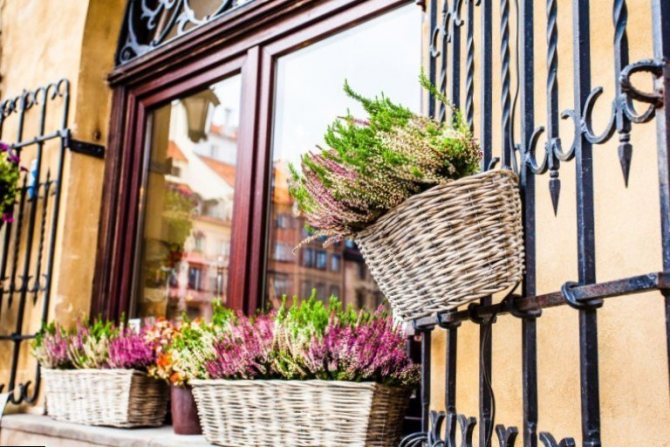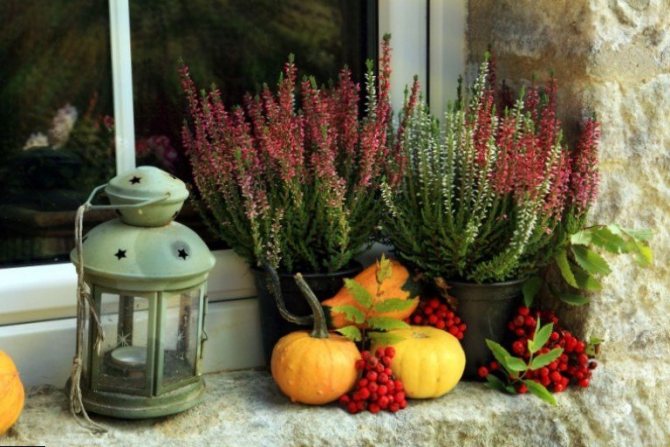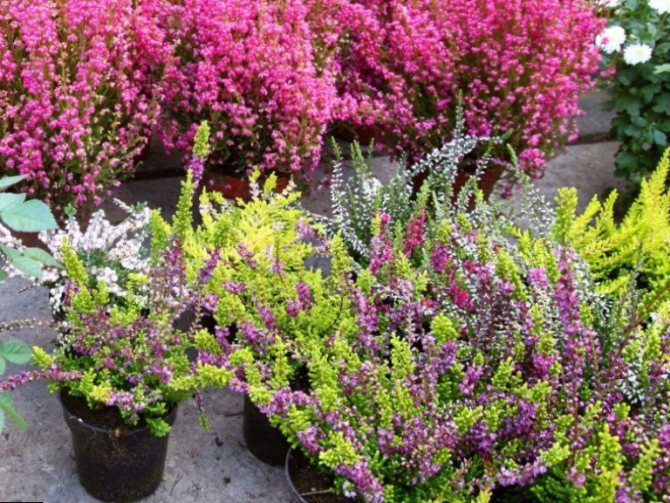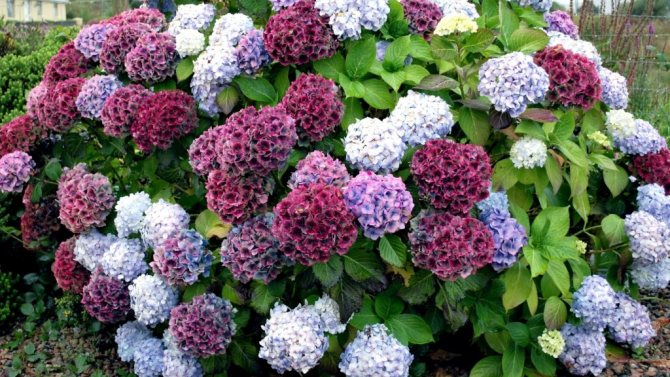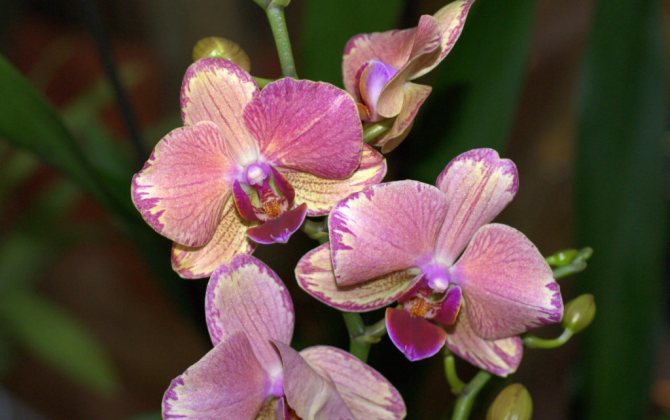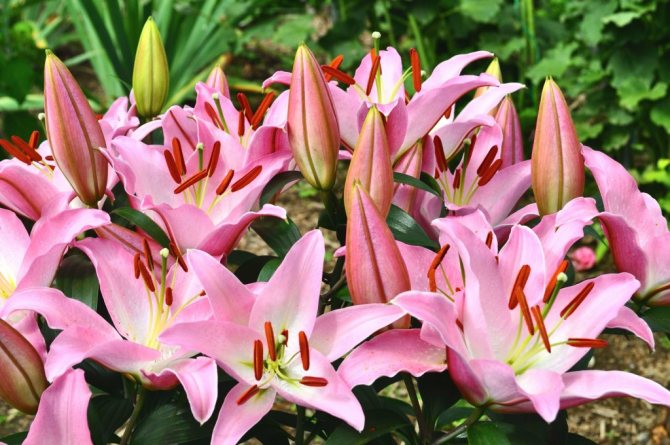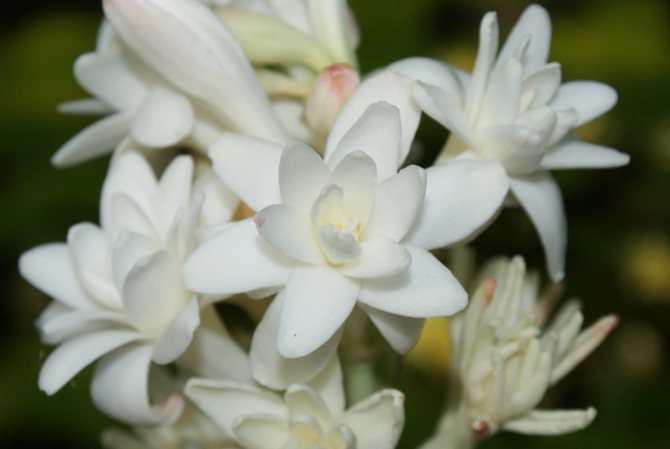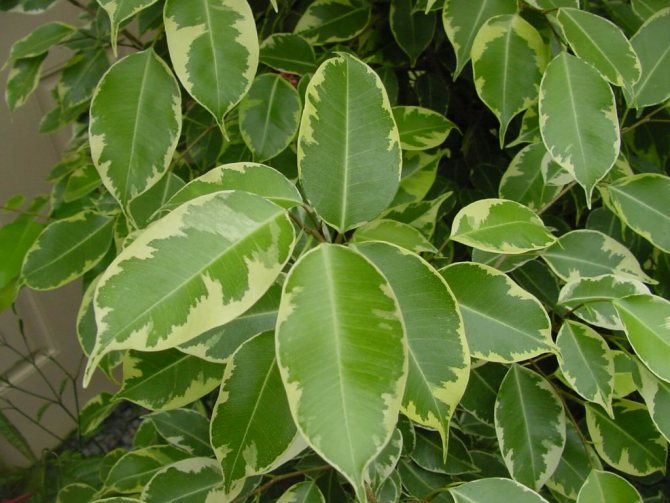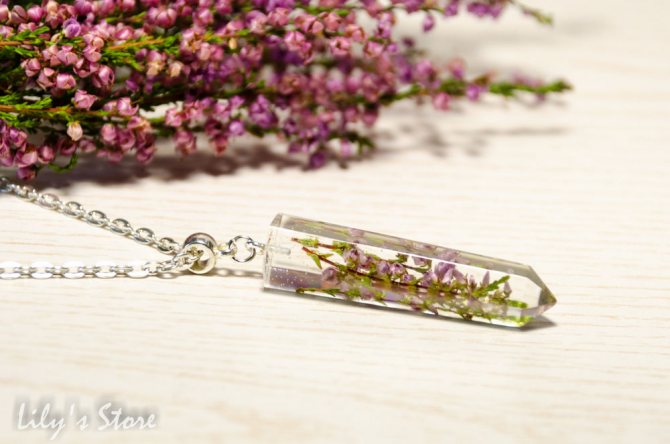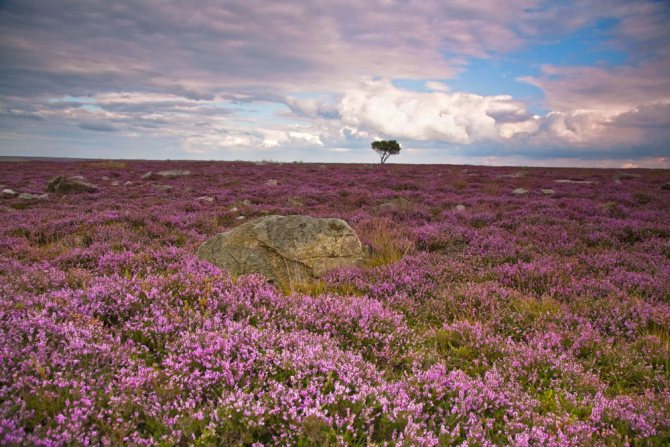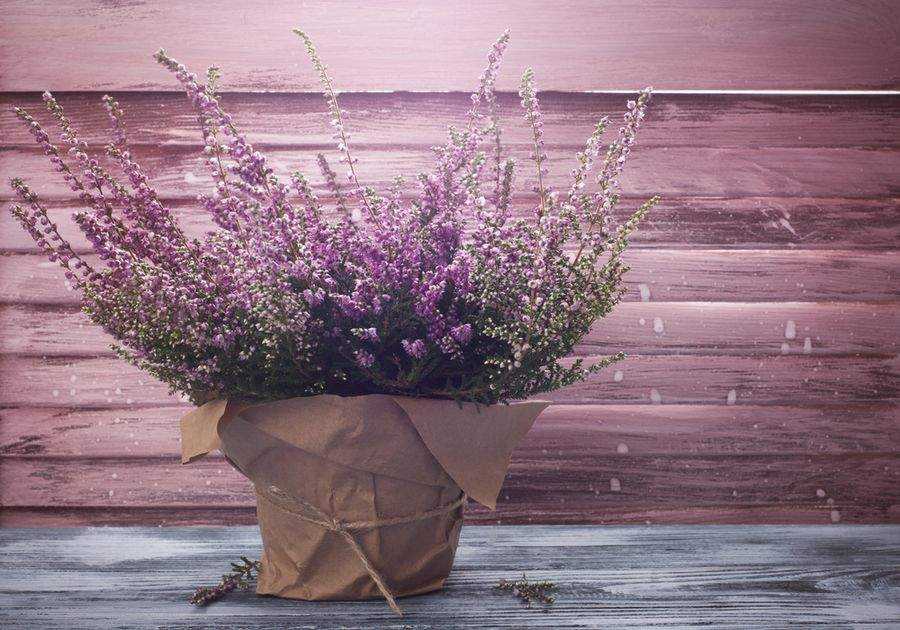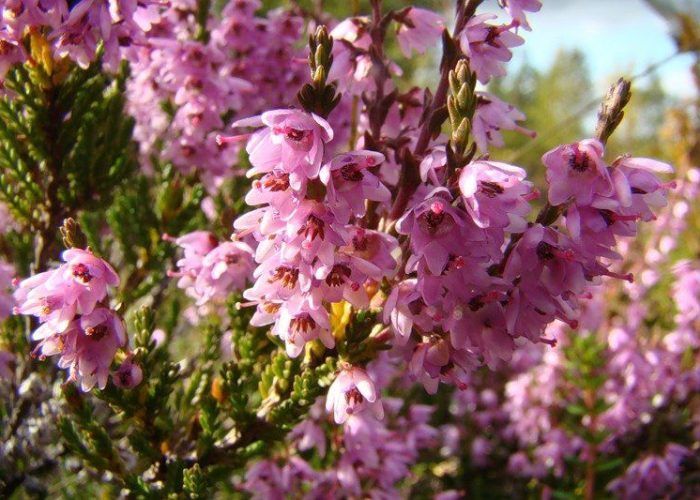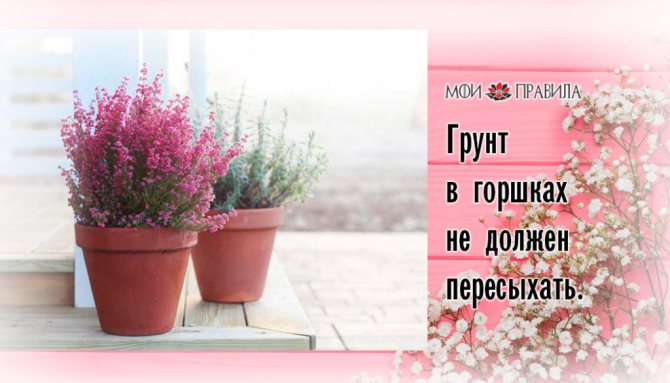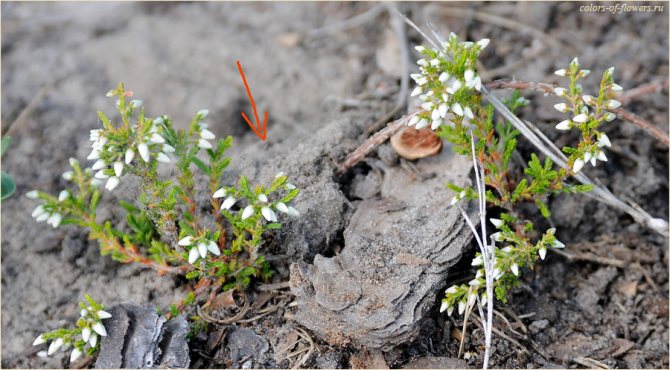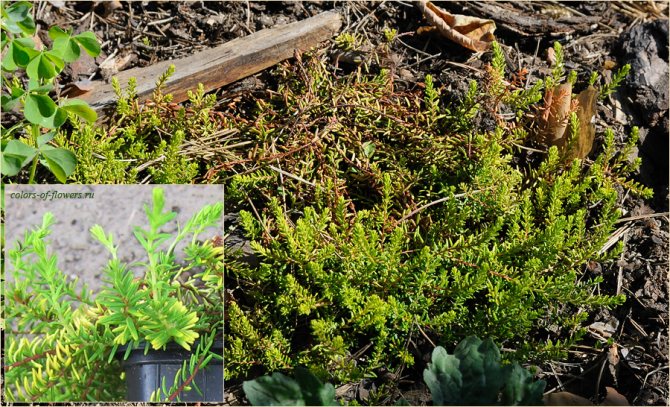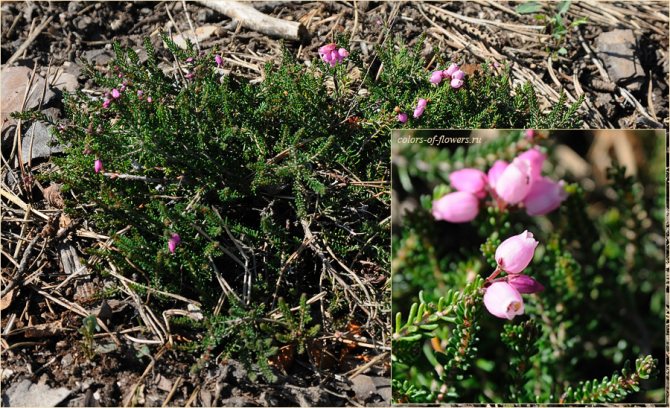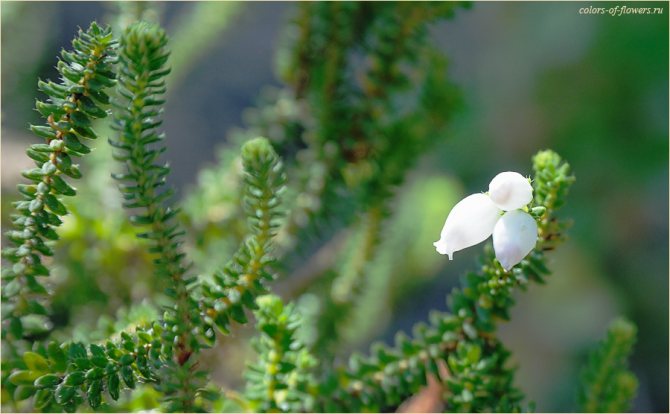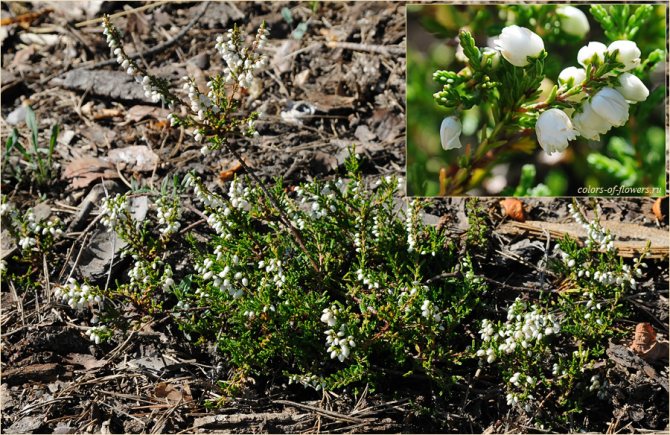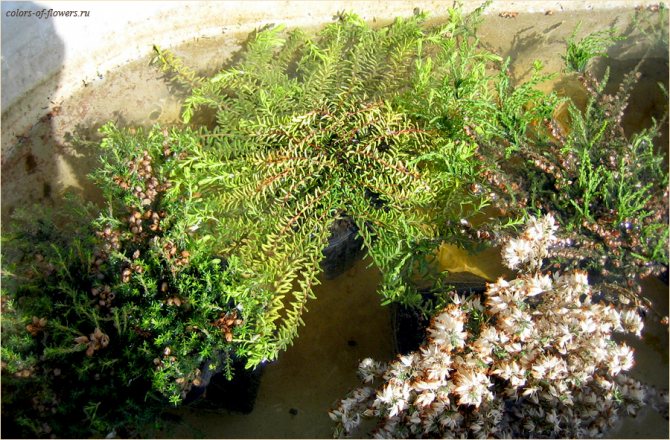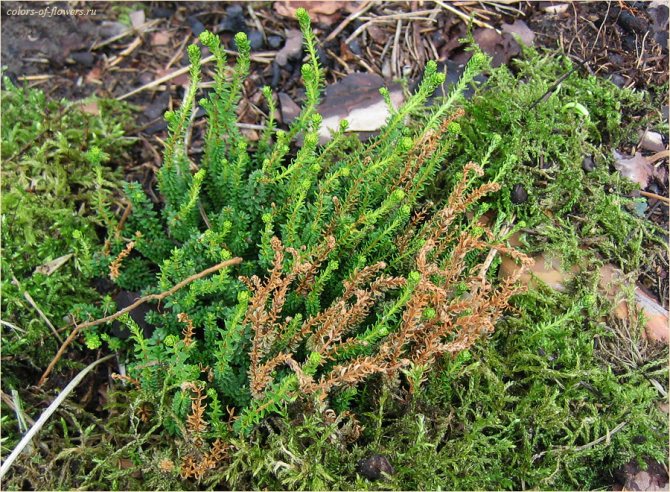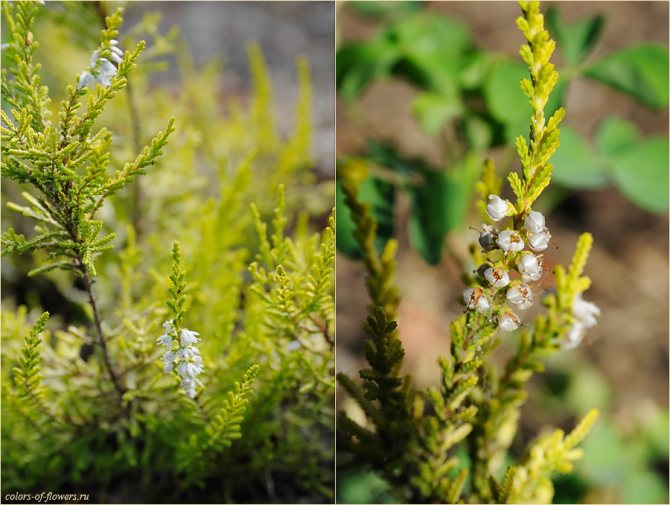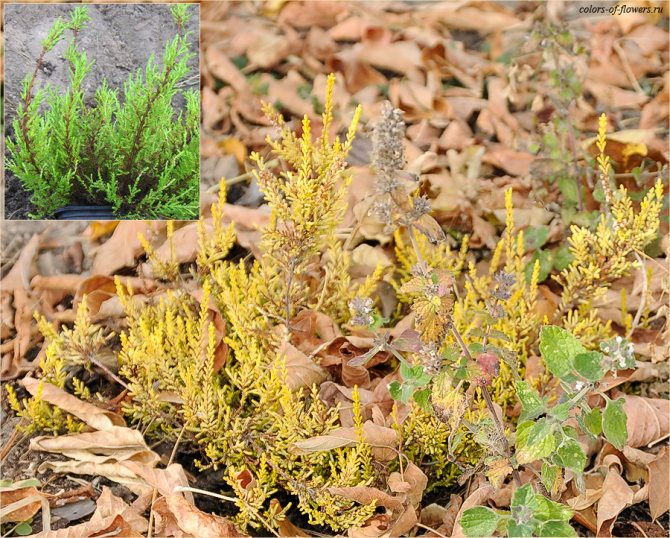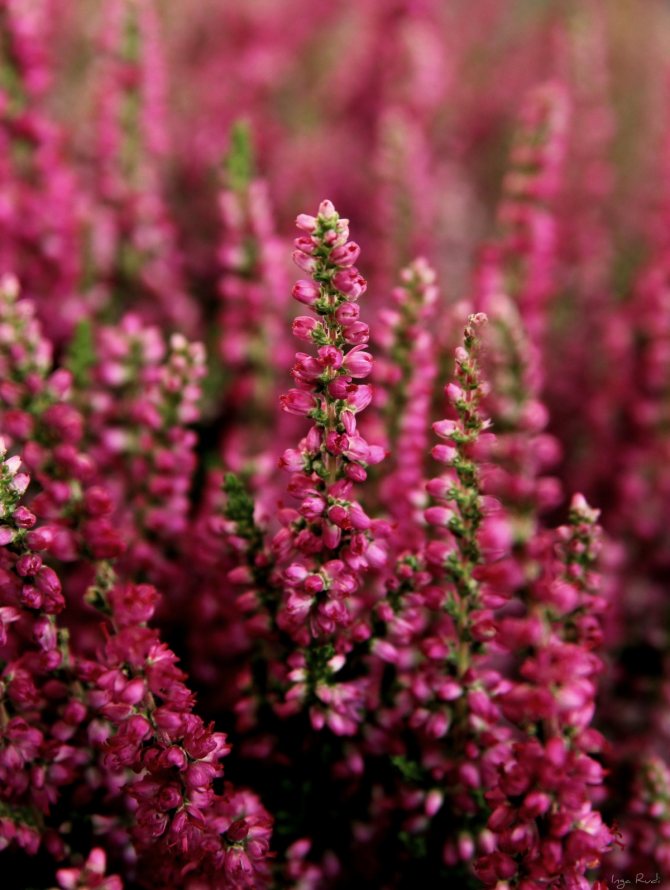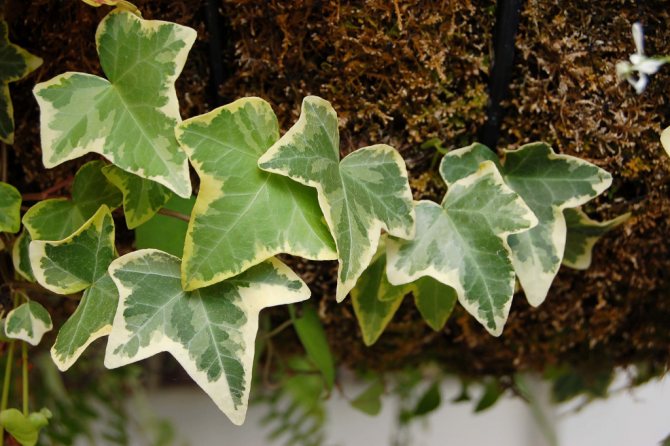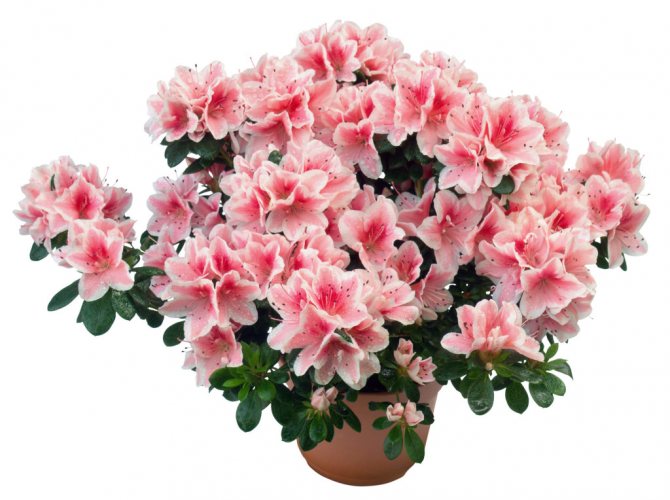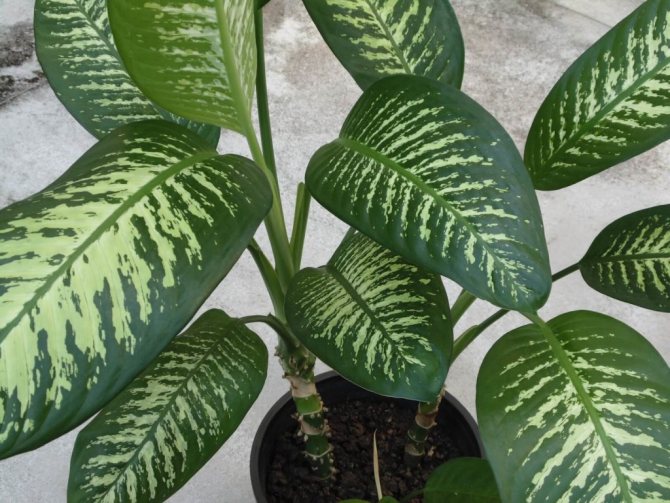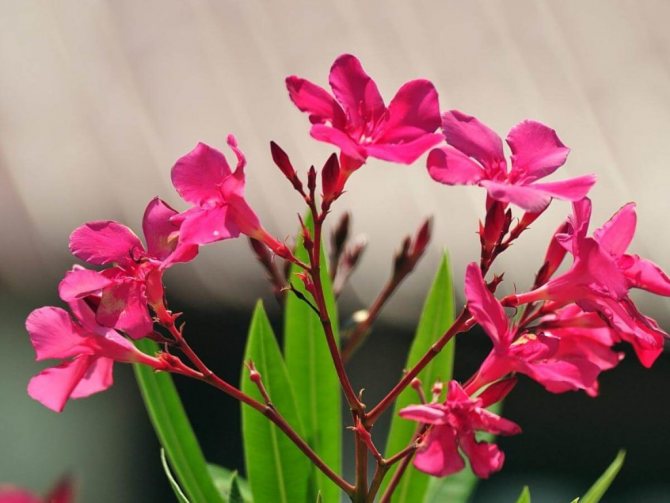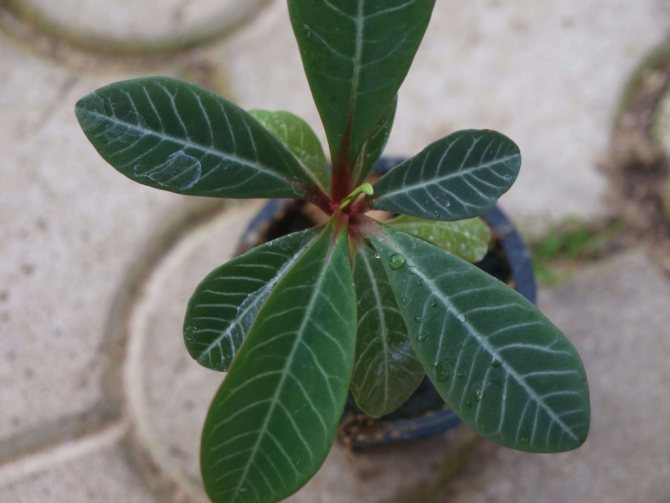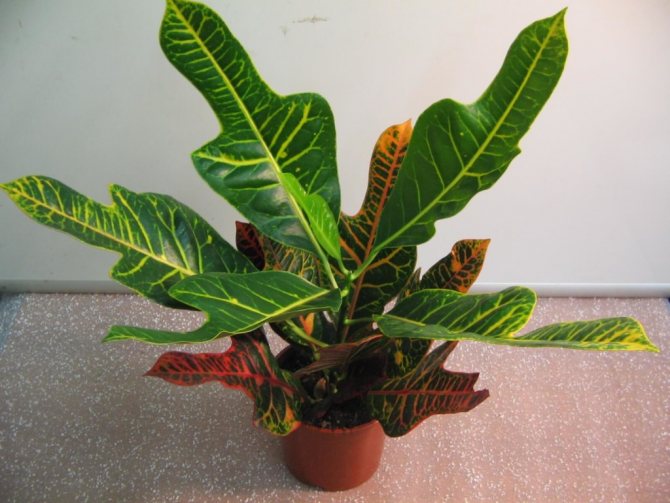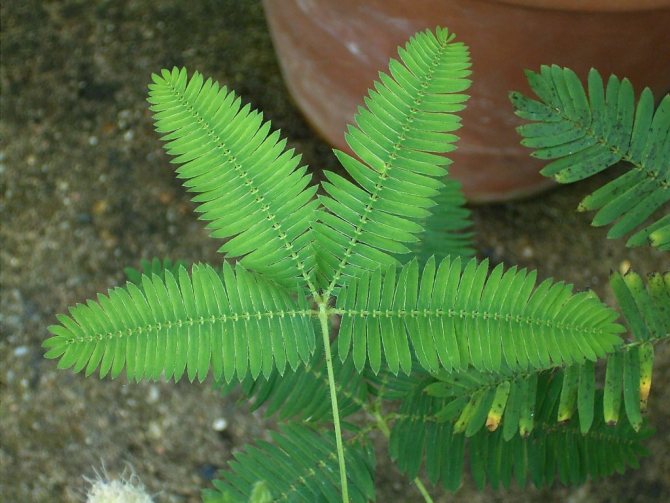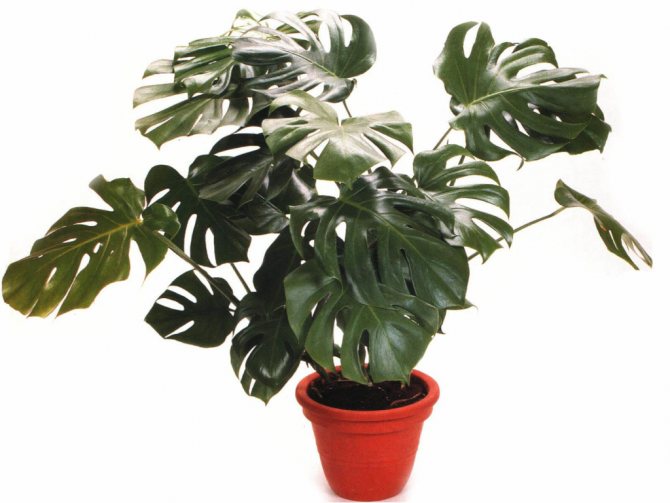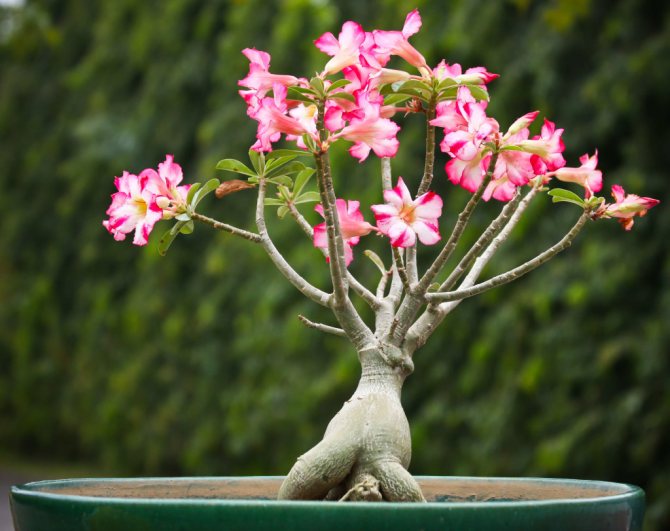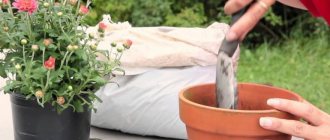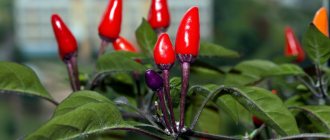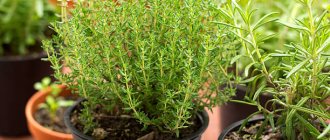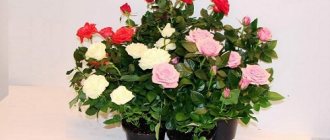At the beginning of autumn, pots of heather appear on sale in garden centers - one of the most beautiful and popular autumn flowering plants used to decorate balconies, windows and terraces.
In its natural environment, a culture can grow up to 10-15 years, in a garden its life is 3-4 years, in a room without proper care the flower rarely survives the winter.
That is why it is most often used as a seasonal ornamental plant, and in order to prolong the life of heather at home, careful care and specific conditions of detention are required, without which the flowering bush dries quickly.
But even after its death, the wasteland flower does not lose its decorative effect and is often used in various floristic compositions.
Potted heather
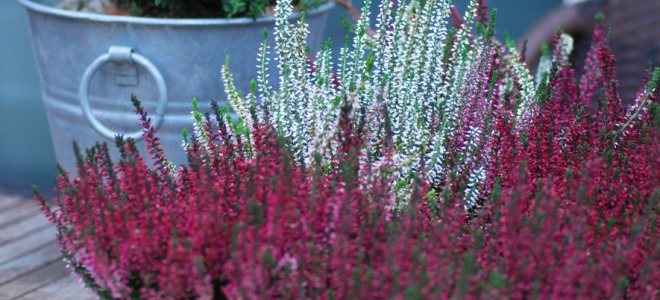
Surely many are familiar with the beautifully flowering heather plant that adorns the glades. But it can be successfully grown at home. Many varieties of heather can be grown in tubs or pots on an insulated balcony. You can also keep the plant in the room.
Heather at home in a pot - how to care?
In order for heather in a pot to develop well at home and delight you with its flowering, you need to follow certain rules for caring for it. They are as follows:
- maintaining optimal temperature conditions. In the spring and summer season, the flower should be kept at room temperature. But in the fall and winter, he definitely needs to provide coolness. The best option would be if the room temperature is 6-10 ° C;
- In order for the heather at home in a pot to bloom luxuriantly, it needs to provide a bright color. The flower can be safely placed in a place where direct sunlight falls;
- an important condition for keeping a plant is compliance with the rule of how to water heather in a pot. During the continuation of the growing season, it is necessary to carry out abundant watering. In the winter season, the flower can be watered less often. But, at the same time, the amount of watering should be controlled in order to prevent waterlogging of the plant. It is best to use settled water. It should be at room temperature and exclude the presence of chlorine and lime in its composition;
- spraying heather leaves in spring and summer;
- during the period of active growth (in summer and autumn), it is imperative to feed the flower with mineral fertilizers. They are placed in the soil around the plant, avoiding contact with the leaves;
- monitor the acidity of the soil, for this add spruce or gray bark;
- if the plant is kept on an open balcony, with the onset of frost, it must be brought into the room.
Heather transplant
If the plant grows, it is transplanted so that the root system feels free. At the same time, they ensure compliance with the following requirements:
- selection of soil mixture. It can be universal, with the addition of agroperlite or vermiculite. A good option would be to plant the flower in soil intended for azaleas;
- the correct choice of container in which the plant will be planted. The best option would be a fairly wide pot, shallow in depth. It should be sized according to the size of the heather root system.
Following the necessary potted heather care guidelines will help you grow a beautiful and healthy plant.
Found a reason why heathers dry
The stores sell winter-hardy varieties that adapt to the weather conditions of the middle lane. However, due to the non-standard spring, even they may suffer. This is especially true when the thaw begins in February. The temperature is unusually warm during the day. Nevertheless, it sinks at night, which leads to freezing of the earth. In the morning, the cycle repeats again. This play of contrasts between moisture and temperature weakens the culture. After all, heathers dry for the reason that:
- green leaves, hearing the heat, begin to evaporate;
- frozen soil is not able to saturate the rhizomes with nutritious moisture;
- as a result, the liquid does not reach the top, so the branches dry out.
It turns out that the bushes just burn out in the sun. Therefore, if such climatic anomalies have yet to return, then it is important to make a canopy for the flower bed. It is made of dense mesh, spunbond or burlap. At the same time, there must be excellent ventilation under it, otherwise the shelter will float and mold will appear on the branches.
When constructing a hut for a flower bed, it is worth considering that a lot of snow can settle on it. He, in turn, will strangle and break the bush. For this reason, many advise first to close the heathers with a box, and then lay the material on it.
Among other things, you can rehabilitate a plant from such a spring with a regular haircut. Just prune the bush not too short. Remove dried shoots that are visible from under the snow. It is important to understand that young buds are concentrated in the upper part of the stem. They are not afraid to do the procedure, because in the same season they will expel branches 5 times more than the previous ones.
For a note
Older specimens do not tolerate any pruning well. In this regard, they will need more time to restore their decorative effect. Abundant watering will help to speed up the process. Depending on the type of soil, the water is diluted with lemon juice or vinegar. Acid fertilizers are periodically applied, intended for azaleas or blueberries.
The next time the heathers begin to dry, the gardener will know it's important to keep an eye on the spring and shade them in time. But the most important thing is that they are not afraid to cut off damaged bushes. This is the only way to preserve the beauty and health of your plants.
Tell me how to tell if heather is alive or not? All the heathers and eriks came out of winter perfectly, green. And now one of them is starting to turn brown. So far, not entirely, but only separate branches. So I don’t know - is it time to clean it up, or does it happen and it will go away?
| Nigma |
| Moscow |
| 30.03.2007 |
| 12:38:10 |
| SergeyA. |
| Minsk |
| 30.03.2007 |
| 00:40:14 |
Nigma, I have this story every year. But I never cut it off right away, you have to wait. Some twigs can move away, and some will have to be cut. And now my heather is in an ugly state. But something green still remains. I will wait.
| levmarina |
| Moscow |
| 30.03.2007 |
| 08:39:20 |
levmarina! I will see my heather only tomorrow, but it also wintered the first year. In short, if everything is bad, then how long to wait until he comes to his senses. Shouldn't you spill something now?
| Volume |
| Moscow |
| 30.03.2007 |
| 10:23:30 |
No need to touch the heathers, especially the newly planted ones, they will leave somewhere in June. It would seem - completely dry and brown, but time passes - it turns green and even blooms! In general, by the end of June it will be more clear.
| Abelle |
| Moscow |
| 30.03.2007 |
| 13:01:23 |
Wait for new growths, then cut dry. Epin or Zircon will not be superfluous.
| Inga |
| Khabarovsk |
| 30.03.2007 |
| 13:48:21 |
Abelle, Inga! Thank you!
Proper planting and heather care at home
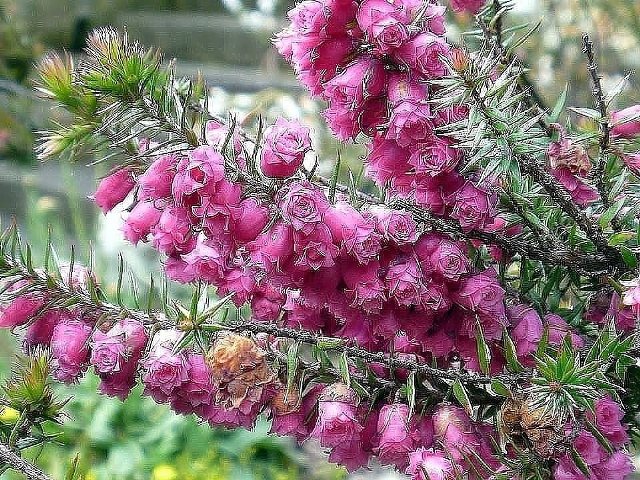

Heather belongs to low-growing evergreen shrubs, during the flowering period, very effectively forming a single carpet of colors of white, red, purple and lilac with a pleasant smell. If a forest bush is planted in the garden, then even during the first frost, flowers in the form of small bells continue to remain on the bush, pleasing the gardener's eye.
This plant is used in the garden as a decoration for an alpine slide, curb or rockery, as well as indoors in a pot. Despite the fact that heather is a rather unpretentious plant, it is very picky about light and soil quality, especially in indoor conditions. In too dark places, it will not bloom, and if there is insufficient watering, it will wither, also does not like frequent transplants, so it is recommended to immediately think about where it will be planted.
When planting heather in a home pot, you need to take into account that it is mainly an annual plant, therefore, in order to preserve the bush, it must be cut off and transplanted once a year after flowering. In this article, we will show you how to care for shrubs at home and in the garden.
The beneficial properties of heather
In herbal medicine, heather is known as an anti-inflammatory, diuretic, sedative. They also make baths and compresses from it for radiculitis, rheumatism, bruises.
Prepared from heather and tea. A pinch of wild raspberry, strawberry, rowan, linden leaves are added to a pinch of dry heather flowers and brewed like regular tea. It will be even tastier if you let it brew for 4-5 hours. Heather is harvested when it blooms profusely. Its leafy branches are dried in the shade with good ventilation and stored for 2 years.
Heather is a good honey plant, although its honey is tart and bitter. The English writer Robert Louis Stevenson, a Scottish by birth, presented in verse form the old Scottish ballad "Heather Honey" (we know it in the translation of S. Marshak). I will not retell it, I think that many have read and remember this very poetic and full of tragedy work.
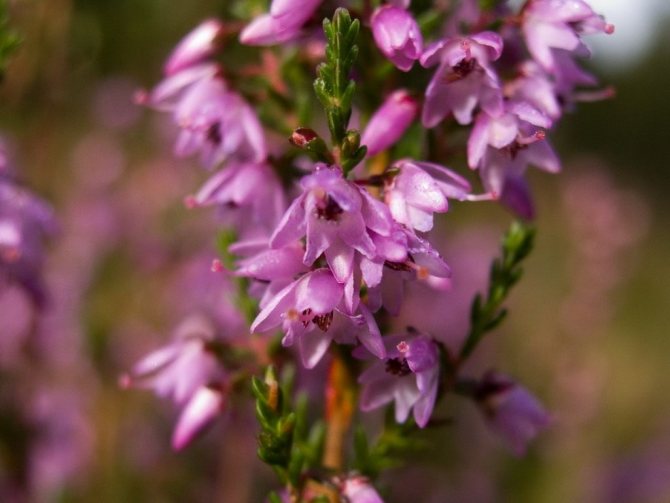

Heather inflorescence
Rules for planting a heather flower at home in a garden
For indoor maintenance, heather is planted in pots, placed on a balcony or window (the south side with direct sunlight is destructive, and the east and west are ideal, so consider the location), periodically airing the room.
Flowering shrub heather
For planting, it is important to make sure that the plant has not dried out, since the flowering type of flowers retains for a long time after dying off. You also need to examine the roots for decay - there should be no gray plaque on the ground.
For planting in a garden plot, the features are the same, and given that in nature the flower grows best on peat bogs, stony soils and wastelands, we think over the place and prepare the appropriate soil.
Heather in nature
Common heather (Calluna vulgaris) description of the plant, care and diseases, watering and reproduction
Heather family Description
Common heather (Calluna. Vulgaris) - undersized (creeping or ascending), evergreen, dense, branched shrub, rarely growing above 30 cm. Its branches are covered with narrow evergreen small leaves, among which at the end of summer mauve flowers that resemble bells open. They are collected in multi-flowered paniculate inflorescences at the ends of the branches. The root system of heather is fine-fibred and densely branched, with a long and widely branched main root.
The most important condition for the existence of plants of this family was their "cohabitation" (symbiosis) with mushrooms. Fungus filaments closely intertwine the roots of heathers, supplying them with nitrogen and other nutrients from the soil. Plants that do not have mycorrhiza die, despite careful maintenance.
Therefore, everyone who wants the wild heather purchased or brought from the forest to take root in the garden should take a walk in the forest and collect land among the thickets of its close relatives, such as blueberries or wild rosemary. If necessary, add three parts of peat and one part to two parts of the soil you brought.
Preparing the soil for planting a plant
The soil must be acidic, this is one of the most important requirements, and the rest is not so critical, although it is better to give preference to a mixture of humus, peat and sand with the addition of sawdust or needles. Also, shortly before planting, it is recommended to additionally oxidize the earth with a special liquid: for 10 liters of water we take 100 grams of apple cider vinegar or citric acid, you can use 50 grams of electrolyte for batteries.
Before planting, the root system of each bush is carefully manually straightened so that the roots look outward and not inward - if this is not done, then the heather will not be able to take root and die. When planting, the root collar of the bush should be slightly higher than the ground, and we lay out drainage at the bottom of each hole. When planting in a pot, you need to take a vessel 5-6 cm wider than the rhizome and be sure to leave a "native" lump of earth on the roots. The ideal time for disembarkation is from mid-April to early June.
If you decide to plant a flower with seeds, then remember that in indoor conditions heather will bloom in two years. Seeds are sown on the surface of the earth and put into a greenhouse (they are covered with a film). After two to three weeks, seedlings will appear, which are transplanted into open ground, preferably in the spring, but it is also possible at the end of September. Plants that have only reached the age of three are cut off, trying not to cut the branches at the root.
Calluna cultivation
The most important thing in caring for calluna vulgaris is to plant the heather correctly. In this case, it can grow in the yard for up to 30 years, and bloom brightly all this time.
But correct purchase is also important. The fact is that in stores sometimes there are completely dry callones, which the sellers forgot to water in time. They can be beautiful for up to 4 months, because the flowers will not fall off. But neither in the yard nor on the balcony this "charm" can not be planted. So before giving money for a bush, check if its branches are bent - if so, the bush is alive. It is also important that the soil in the pot is slightly damp when sold.
Landing
Priming... It's the most important. It may not be very nutritious, but it is loose and always sour. If you buy potting soil for your home flower from a store, make sure that the pH numbers on the bag are in the range of 4.5 - 5.5.
If you have a flower bed and you do not know what acidity the soil is there, you can buy special test strips (they are available in flower shops). You can acidify the soil by digging it up with fresh manure, sphagnum moss, leaf compost, rotted sawdust or pine needles, and high-moor peat.
It is also important that at the bottom of the pot there is drainage - without it, heather that loves to grow in wet ground can die from root rot.
Other important requirements:
- sunny area (partial shade is allowed);
- good water conductivity of the soil;
- wet soil (low groundwater is good for heather, especially freshly planted), but the flower garden should not be swampy.
An experienced gardener will tell in more detail about planting this decorative culture in spring and autumn, as well as the intricacies of this procedure:
Outdoor care
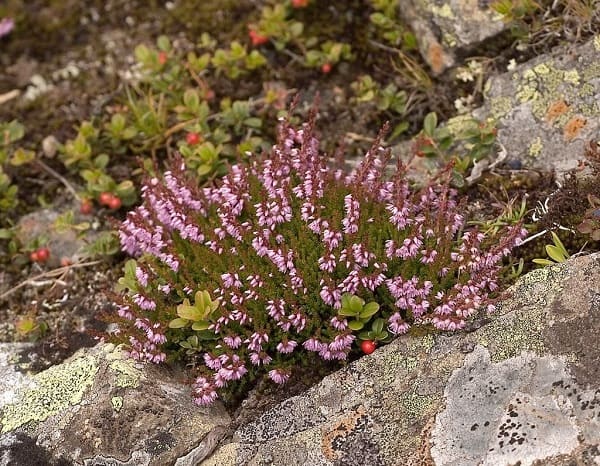

- Abundant watering for the winter, especially in cold regions (and calluna can grow even in Siberia).
- Pests of heather are not terrible, but he can get sick to death with late blight. Therefore, flower beds should not be set up near the vegetable garden and beds so that the heather does not have contact with crops that often suffer from such a disease (and these are potatoes, tomatoes).
- In a warm or middle climate, a semi-shrub does not need shelter for the winter, but in the north it is better to overlay a flower bed with spruce branches (although much depends on the type of flower you planted, they are less and more winter-hardy).
- Mulching with materials acidifying the soil: needles or small bark, sawdust, deciduous humus.
But you do not need to feed the calloon in the flower bed.
You will learn more details about the cultivation of calloon from the expert of the garden center:
Home care
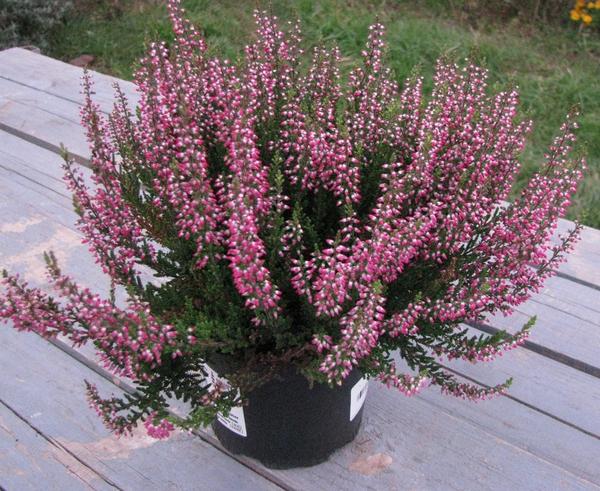

- Ideal content for calluna: about 22 degrees in summer and from +7 to -12 in winter; frequent airing; a lot of sun.In warm regions, heather can be kept on the balcony in winter, and in an apartment under air conditioning in summer.
- Immediately bringing a bush from the store, arrange a warm shower for it - this way you will wash away the dust, and possibly also some pests that have stuck in the store.
- Make sure that the soil in the pot does not swamp, but is constantly slightly moistened. Heather also needs moist air, so it is advisable to keep it constantly (especially in summer and winter) on a pallet with wet sphagnum or expanded clay. In winter, watering is reduced.
- The plant can be sprayed frequently. For both irrigation and spraying, the water must be defended. During the procedure, the water should be lukewarm or room temperature.
- You can feed the callon with organic matter, giving it once a month in spring and summer. And in the first month of spring, after a planned transplant, the plant can be watered with a solution of complex mineral fertilizer.
- A pinch is necessary for indoor callon - thanks to it, the plant shrubs better, which means it blooms more. And when all the flowers dry up, it's time for formative pruning.
- If you have a temperate climate, put the bushes on the balcony every summer. It might even be the sunny side of the house. But remember: the more sun the heather receives, the more water it should receive (not only watering, but also spraying).
How to care after landing?
Heather is considered an unpretentious plant, but there are still some nuances:
- Loves fresh air, but does not tolerate drafts
- An indoor plant needs to be fertilized more often than a garden plant. For this, Kemira Universal or a special fertilizer for azaleas is used. For feeding, the product can be diluted in water or simply scattered over damp earth, slightly sprinkled with mulch. The plant often suffers from overfeeding the soil than from its poverty.
- Periodic mulching of the roots has a beneficial effect on the plant, since its roots are sometimes located above ground level. For this, you can use bark, shavings and sawdust.
- Avoid watering with tap water, which contains too much lime and chlorine
- Be sure to remove dried twigs and leaves.
It is better to water once a week with rain or melt water., you can also settle the water in containers before watering. Add acid to the water periodically. Watering is done at the root, trying not to get on the ground part - the plant can be hit by gray rot, while trying to prevent the topsoil from drying out, which mainly feeds the bush.
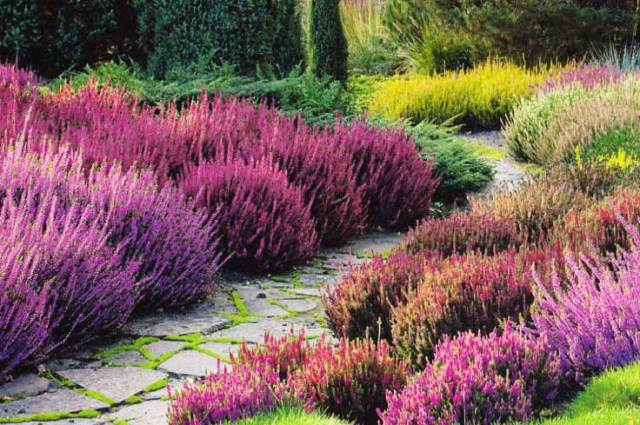

Shrub heather in landscape design
Reproduction is carried out by seeds, dividing the bush and layering. To divide the bush in the spring, after digging the bush, carefully divide it into two or three parts, preserving the earthen coma on the roots and replant it to a new place. When propagating by layering, sprinkle large shoots with earth to a depth of 10 cm. The hill is often moistened so that the roots germinate faster. When the rope takes root, cut it off from the mother bush and transplant.
Let's summarize
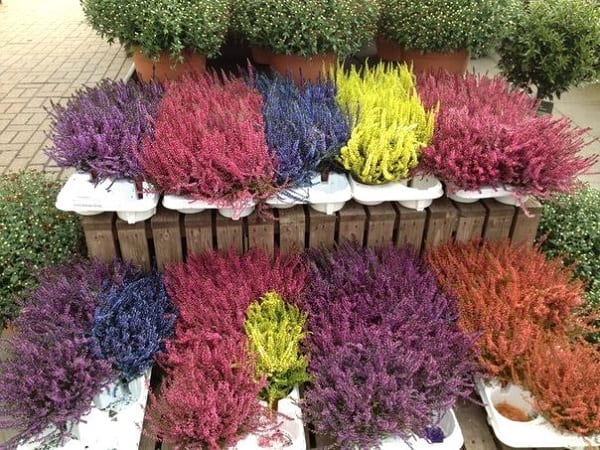

- Calluna is the Latin name for heather. This decorative dwarf shrub is presented in 300 varieties with various shades of leaves and fragrant flowers.
- The plant can be grown in an apartment. It needs to be watered regularly, kept in humid air, and pinched in the spring.
- But of course, more often heather is planted in flower beds. The creeping plant quickly forms a colored carpet. It is important that the soil under the crop is acidic.
And about the most popular varieties of calluna and why it does not always take root in the garden or balcony box, you will learn from this video:
Heather - planting and caring for this grassy crop outdoors is easy. An unpretentious plant is often used in landscape design. It is well suited for delimiting zones with different style solutions and purposes, looks great against the background of conifers and looks great when decorating paths.
Pests and the fight against them
Heather has several enemies that need to be dealt with carefully:
- Aphids (we use Decis, Intra-virus)
- Spider mite (we fight with Aktara and Aktellika)
- Gray rot (use Fundazol, Topaz, Rovral from it)
- Powdery mildew and rust - we spray the bushes with copper preparations
If you create favorable conditions, heather will grow wildly and decorate your home (or plot) with wonderful colors and an extraordinary aroma. And knowing that this plant does not require special care methods, it is perfect not only for experienced flower growers, but also for beginners.
Feng Shui
In Feng Shui, it is important to pay attention not only to the type of flower, but also to the state in which it is. There are several basic rules for keeping flowers and plants in the house according to Feng Shui:
- You should not keep dried flowers in the apartment.
- All old plants that no longer bloom and do not give young shoots should be thrown away.
- Sick flowers should not be kept in the house, as they will take away your health.
- A flower that you take care of for a long time, but all actions are useless, and it withers, should also be removed from the house. The plant spreads negative energy.
- It is worth choosing those flowers whose leaves are directed upwards. According to Feng Shui, such plants bring positive energy to the house. Plants with leaves that stretch down, on the contrary, land it.
- It is better to choose flowers with a rounded leaf shape.
- You shouldn't have a lot of plants in the bedroom and next to the bed.
- According to Feng Shui, all plants are divided into female and male (Yin and Yang). Women include begonia, violet, fat woman, cyclamen. Citrus fruits, dracaena, chlorophytum and others are considered male plants.
- For the most favorable energy field in the house, it is necessary to keep Yin and Yang plants.
Description of the plant
Heather is a bush-shaped perennial plant. Its branches are covered with small bell-like flowers. The shade of flowers can be varied: from white to dark purple. At home, two subspecies of common heather are most often grown: slender and hibernating.
Characteristic features of the plant:
- shrub reaches 40-50 cm in height;
- small leaves are located opposite on the branches;
- flowers are located at the tips of the shoots in 4 pieces;
- the length of flowers differs in different varieties (from 5 mm to 2 cm).
For heather, it is important to choose the right soil - it should be acidic and peaty. Make sure the plant gets enough light and fresh air. The stuffiness in the room and direct sunlight negatively affect the condition of the shrub. The best temperature for keeping it is 10-25 ° C in summer and 12-15 ° C in winter. In the fall and spring, when temperatures are mild, bring the heather outside to fresh air.
Calluna vulgaris (Common heather)
Family. Heather, Ericaceae.
Origin. Europe, Siberia, Asia Minor.
Flowering time. June - November.
Heather - dwarf, 20-90 cm in height, shrub with narrow, scaly leaves of green, yellow or gray-green color. Pink, red or white, bell-like flowers are collected in dense pyramidal inflorescences at the ends of the shoots. There are simple and double varieties that bloom at different times of the year.
With proper care, you can get a closed carpet of heather plants, quite picturesque both in independent heather gardens and on alpine slides, or as a curb along the paths in the country garden. Heathers look spectacular in joint plantings with decorative forms of conifers and flowering shrubs. As a rule, heathers form the foreground, and tall bushes are their background.
Accommodation. In a sunny or semi-shady place, outdoors, in a sandy ground.
Care. In the summer, keep a little humidity at all times. Feed in spring and early summer. Reduce watering in winter, but the plant should not dry out. Trim in the spring.
Reproduction.In the summer, cuttings or ...
Heather planting and home care
Heather propagates in three ways: by seeds, dividing the bush and cuttings. The best temperature for growing seedlings is 18-20 ° C.
Sow seeds at any time of the year in a soil mixture of peat, coniferous soil and sand. Cover the container with grains with foil or glass, ventilate and water the ground from time to time. Plant seedlings in permanent pots 8-10 months after germination.
Cut the cuttings in early autumn from strong shoots without flowers, put in water until roots appear and root in a mixture of peat and sand.
After the end of the flowering of the bush, you can divide the roots for a transplant. To do this, remove the plant from the pot and carefully divide it together with the soil into several parts. Plant the resulting seedlings in separate containers, water and fertilize with a special agent.
Home care:
- do not allow the earth to dry out;
- water with settled water without chlorine;
- in the off-season, spray the branches with warm water;
- feed the soil with organic and mineral fertilizers, especially during the period of active growth;
- acidify the soil in the pot with spruce bark or sulfur;
- transplant the plant into a larger pot every year, while trying not to damage the earthen ball.
After flowering, prune young shoots, keeping the shape of the bushes. Such manipulations will stimulate the appearance of new branches and buds.
With proper care, heather will decorate your home for years.
Folk signs: what is possible, what is not?
To trust folk omens or not is a personal matter for everyone. At the same time, it is worth remembering that most often signs arise on the basis of long-term observations of ancestors. Consider what the appearance of some indoor plants in the house entails:
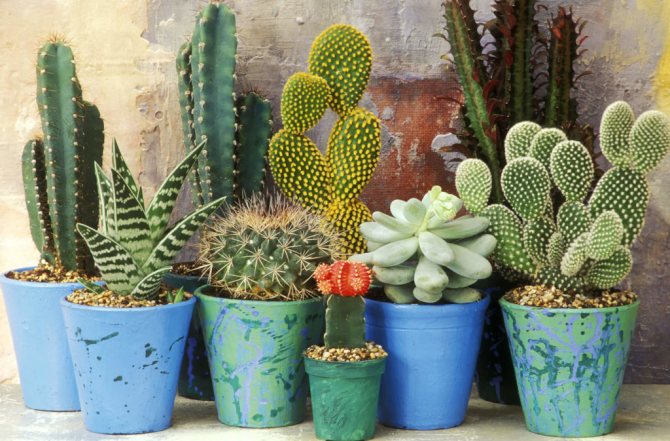

Cacti are unfavorable plants for the home. It is believed that the presence of a cactus in the apartment turns the husband into a person suffering from alcoholism. There is a second sign, which says that in a house where there is a cactus, a girl will not marry happily or will not meet a chosen one at all. Also, cactus has a bad effect on relationships between family members.- Ferns take vitality from a person, being an energy vampire. In a house with a fern, a person will feel constantly tired, inactive, sleepy.
- Ivy and climbing plants, according to folk signs, scare men away. In a house where there are such plants, a man will constantly strive to go somewhere. In addition, ivy negatively affects the state of mind, depriving a person of optimism and balance. It is best to keep these plants outside the house. So, ivy will act as a protector.
- Dieffenbachia is dangerous for its poisonous properties, and also takes health away from the household.
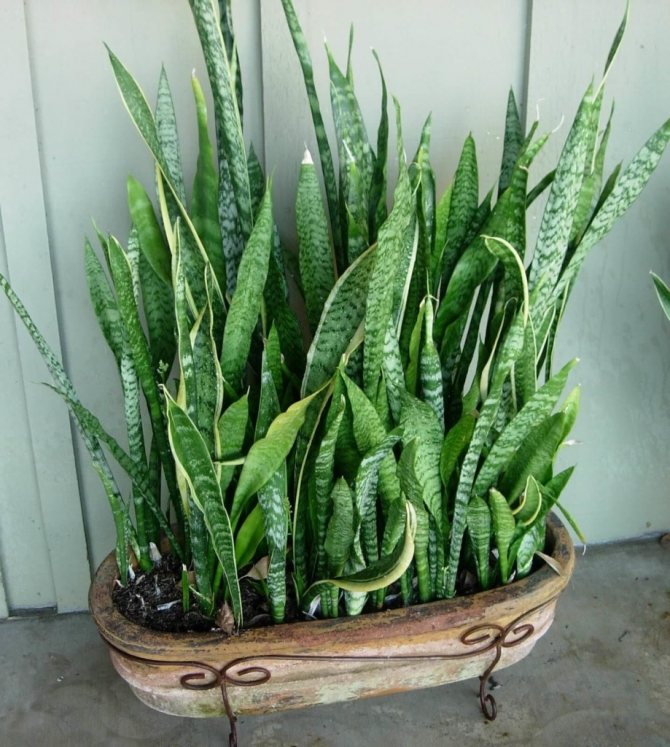

Mother-in-law's tongue is a plant that has practically no stem, with elongated longitudinal leaves with a bright green color. It is believed that the presence of such a flower in the house leads to loneliness and the inability of the girl to get married. The plant has a negative effect on feminine strength, so it is dangerous to keep it in the bedroom. The flower "drives" men out of the house.- Sansevieria is a curious plant that looks like the tail of a fish. For this reason, it is also nicknamed the "pike tail". The leaves of the flower, painted green, have such a bizarre shape. The plant blooms and has a pleasant aroma. But, according to the signs, it negatively affects family and personal life. The presence of this flower in the house leads to loneliness.
- The palm tree often decorates the interiors of many rooms, but it is better not to put such a flower at home. The palm tree contributes to the appearance of grief in the family, if it was presented to you. Save this plant for office spaces or other locations.
- Ficus can cause allergies, but in addition, it is believed that the flower negatively affects the appearance of children in the house. If you want a child, then this plant is not worth purchasing.There has been a long debate about ficus. There is a directly opposite opinion on this plant. It says that ficus solves the problem of infertility and contributes to family well-being.
When organizing a flower corner in an apartment or landscaping your home, choose the flowers that best suit you based on your lifestyle, the appearance of the flower and its properties.
Heather: care and reproduction at home
Heather belongs to the numerous heather family, which has more than 500 species. Most species are native to Africa. Heather – it is an evergreen shrub, the stems of which are dotted with small flowers, shaped like bells of all kinds of shades of lilac, lilac, white, pink and purple.
In nature, common heather is most often found, and slender heather and wintering heather are adapted to domestic conditions.
Heather slender - evergreen shrub up to 40 cm high. Leaves are light green, up to 5 mm long. The flowers are pink-red in color, located at the ends of the lateral shoots, 4 pcs. in everyone.
Wintering heather grows up to 50 cm in height, and its flowers are larger (up to 2 cm) and have a white color.
COLOR PALETTE OF VERESKA VARIETIES
Florists and gardeners pay attention to heather quite often. This is due not only to the fact that it can grow even in marshy, mountainous and sandy conditions, but more with its beautiful elegant texture. Although there is only one species in nature - common heather or Calluna vulgaris, the color palette of its various varieties (more than 300) allows you to choose the most suitable options for the color shades of flowers and foliage:
- Purple, white, or lilac-pink bells with needle-like juicy green leaves, like ornamental heather.
- Pure white or greenish-white inflorescences and small bluish foliage are characteristic of the tree variety.
- Red or pink flowers, collected in a cluster, and bright green leaves can be seen when Calluna Rose blooms.
- Terry light pink flowers and dark greens (such an option as the "Bil" variety).
- Lilac or lilac-pinkish buds and golden-yellow (in summer) or copper-crimson (in autumn) leaves are amazing metamorphoses of varieties such as "Boskop" and "Golden".
These shades are the most common. But there are also other variations - purple and ruby red inflorescences, purple and dark pink flowers, and the greens sometimes take on gray-white and orange hues.
Planting heather
If you decide to plant heather at home, keep in mind that it is cultivated at home as an annual plant.
You can grow it further: after the plant has faded, you should feed the soil, and then cut the bush, only then the plant will retain its attractive appearance for the next year.
Requirements for planting material
The root system of the plant must be closed, otherwise it will be damaged and the heather will die.
Shoots should be elastic and leafy, and active vegetative buds should be present at their ends.
Pot and soil requirements
Indoor types of heather are very demanding on the soil.
Peaty or acidic sandy substrates are best suited for them. The pot should be deeper than the length of the roots.
Flower planting scheme
- We fill the bottom of the pot with the necessary substrate for a few centimeters so that the root system can grow in the future;
- Then we very carefully move the planting material into the pot so that the root system remains intact;
- We fill up the missing soil, while not ramming it, otherwise the root system can be damaged;
- In conclusion, the plant can be watered, add some more earth. The filling process must be repeated several times as necessary.
First steps after purchase
When purchasing such a beautiful plant as Heather, you should pay attention to the condition of the branches and flowers.The fact is that the bush can die from even short-term drying out of the soil during transportation. This will not affect the appearance at all. It does not lose its decorative effect for months and stands beautifully as a dried flower. Still, I want to get this treasure alive. Therefore, you need to check the condition of the plant before buying it. The branches should be flexible, lively, and the flowers should not crumble.
Rules for caring for heather in a pot
In order for the plant to continue to delight you with its beauty, you need to know how to care for heather at home. To do this, it is enough to follow simple but important rules:
- Water the plant only with clean water, free of chlorine and lime, at room temperature;
- The substrate must not be overdried;
- Temperature regime in summer +18 -25 ° С, in winter - +8 -12 ° С;
- In the off-season, if possible, take it outside, while protecting the plant from drafts;
- During the spring-autumn period, it is necessary to spray the plant with warm water daily;
- Make top dressing in a timely manner;
- Periodically acidify the soil with spruce bark or sulfur.
Watering and spraying rules
Heather requires regular, but not heavy watering to keep the soil moist. Spraying is necessary only in the warm season.
Feeding
Top dressing is necessary for heather annually. For this, complex mineral fertilizers are used, which can be bought in a special store. They need to be scattered around the plant, while it is very important not to touch the flowers and leaves, they can “burn out” from a high concentration of fertilizers.
Features of flower transplant
Heather is very difficult to tolerate a transplant, since it has an underdeveloped root system. It can damage the roots, as well as mycorrhizal mycorrhiza.
Therefore, for the home, heather is usually bought in special containers, and transplanted together with a lump of earth. Also, replanting can destroy the heather if the new soil is not acidified enough and turns out to be neutral or alkaline.
Success secrets
For Heather, acidic (pH 4.5–5.5) is suitable, not very nutritious, but loose soil, which should be constantly moist, but without blocking. It is very important to make good drainage, otherwise the plant can quickly die.
Watering and spraying the plant is often necessary with well-settled soft water at room temperature. During the rest period, watering is reduced, feeding is not done at all.
During the growing season and flowering, the plant responds well to feeding with organic fertilizers once a month. At the beginning of spring, you need to transplant it and feed it with full mineral fertilizer once.
The symbiosis of Heather with some types of soil fungi is very interesting, which help it to assimilate nutrients and enrich the soil. The result is a heather soil that can later be used to plant Hydrangeas, Azaleas and plants that prefer acidic soils.
Heather loves cool rooms, fresh air and lots of sunshine. Keeping at low temperatures + 7–12 ° С in winter and up to + 20–24 ° С in summer will not allow Veresk to die. It does not tolerate even short-term dryness of the soil and hot, dry air. Frequent spraying will do him good.
How to propagate heather at home
Heather reproduces at home in three ways:
- seeds;
- cuttings;
- dividing the bush.
Plant seeds you can at any time, no special conditions are needed for this. Seeds are planted in bowls with a substrate, which consists of one part of coniferous, two parts of peat land and one part of river sand. There is no need to "sink" the seeds into the soil. The dish must be covered with glass until shoots appear.
If all conditions are met, they should appear approximately 3-4 weeks after sowing. During the first week, the humidity should be kept high, and then the sprouts should be sprayed about 4-5 times a month.For the summer, be sure to take them out into the fresh air.
You can plant in pots after 8-10 months.
Cuttings cut at the end of summer for breeding. It is necessary to use for this not flowering, strong shoots. The cuttings should be rooted in separate pots. A loose soil mixture of equal proportions of peat and sand, poor in nutrients, is suitable, and it must be constantly moistened. Rooting occurs at a temperature of + 15-20 ° C.
However, the safest, easiest and fastest way to propagate heather is separation of rhizomes into two parts. This procedure must be carried out after flowering. The plant must be removed from the pot and divided into parts.
In any case, it will not be possible to avoid damage to the root system, but still try to do it as delicately as possible. Then both parts are planted in pots as independent plants, watered abundantly and must be fed.
Where and how to plant?
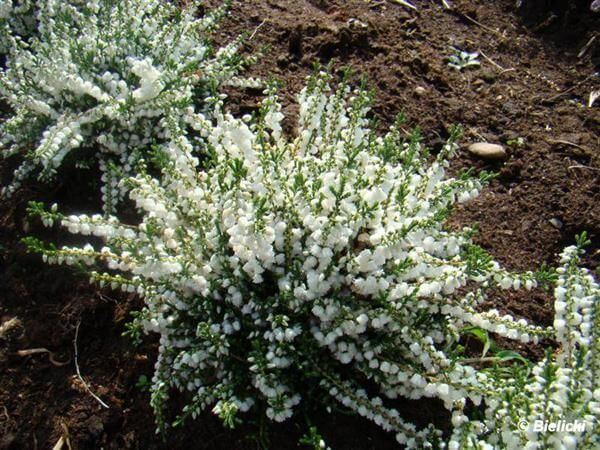

Heathers love acidic soils, preferring dry sandy or wet peat soils. If the soil is moist and clayey, drainage is required. Without it, in a low and damp place, the plant will die. And in very dry areas, heather will winter well. But it will not give a dense crown and in the future it will completely stop blooming. Therefore, choose the "golden mean"! Heather grows very well on alpine hills, where water does not linger, and gravel does not allow the roots of the bush to dry out.
The best time to plant heathers is spring. Then, for the coming season, the plants will have time to take root well.
When buying heathers for planting in containers, carefully examine the bush. The fact is that even if the bush has died and dried up, it retains its original appearance for a long time! So make sure the twigs are flexible enough and have buds and fresh shoots at the ends that are lighter in color than the rest. The soil in the container must be sufficiently moist.
Before planting, remove the plant from the container and gently knead the earthen ball, carefully straightening the roots. If this is not done, the plant will not be able to provide itself with sufficient nutrition and will die.
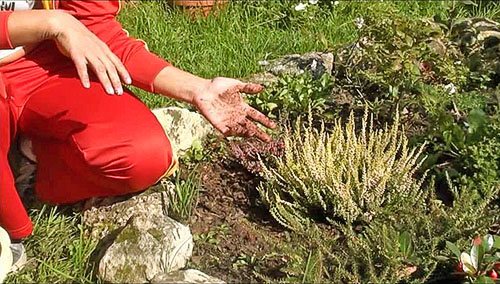

For planting, prepare an acidic substrate. We mix 1 part of sand, 3 parts of red high-moor peat and 2 parts of coniferous land (we take it in a coniferous forest from a depth of 5-7 cm). We fill the planting pits with this substrate.
We plant heather bushes in groups, in a checkerboard pattern - one by one, they do not look so impressive.
The distance between plants is 40-50 cm. On average, 1 sq. M. m of soil we plant 8 strong-growing bushes or 12 slow-growing ones. Planting depth should be 25 cm. After planting, water the plants abundantly and be sure to mulch - with peat, chips or bark of coniferous trees.
Heather has one more feature to consider. Its root system has a symbiosis with myceliums, so the plant does not tolerate transplanting well. In order not to expose shrubs to stress, it is better to immediately plant them in a permanent place in the garden.
Diseases and pests of the flower
Heather flower diseases and pests are much less common at home than when grown outdoors, but there is still a risk, mainly due to excess soil moisture.
The main pests that can infect a plant are scabbards... As a treatment, morning sprays with soapy water are used.
When water stagnates in the roots, the plant affects gray rot... The first signs are gray bloom on the shoots, foliage falling, partial death of young shoots.
When they appear, it is urgent to treat the plant with antifungal drugs. Processing is carried out in 2-3 doses with an interval of 6-10 days. For prevention, early spring or late autumn is best suited.
If the leaves turn brown, and the tops of the young shoots begin to wither, this is a sign that you overdid it with fertilizers.
Another plant can strike powdery mildew... Because of this disease, young shoots begin to dry out, and the leaves become covered with a grayish bloom. For treatment, as in the case of gray rot, you need to use antifungal drugs.
Particularly dangerous viral diseases... Symptoms: noticeable deformation of flowers and shoots, their unusual color.
In this case, the plant urgently needs to be dug up and burned, since there are no effective methods of treatment for these diseases.
Possible difficulties
The bush grows slowly
The reason: 1) excess nitrogen in the soil, 2) unsuitable soil acidity.
Branches and flowers dry
Reason: 1) non-observance of the irrigation regime and overdrying of the soil, 2) excessive dryness of the air, 3) insufficient acidity of the soil.
The leaves turned brown and the young shoots withered
Reason: 1) waterlogging and stagnation of water in the soil, 2) excess of nutrients.
A grayish-white bloom appeared on the leaves
Reason: 1) powdery mildew.
Subscribe and receive descriptions of new species and varieties in the section "ornamental trees and shrubs" by mail!
Petunias are growing on my balcony all summer, while the boxes are empty in winter. One friend advised to plant heather in them in the fall - they say, it will stick around all winter with colored hats, decorating the balcony. I had no doubts for a long time, in the same year I planted four varieties at once. And they all happily withered away.
I don't like to give up halfway through, and if something doesn't work out, I rush to figure out what went wrong. I went to the garden center for a consultation. It turned out that the soil in which the petunias grew and which I carefully fed with mineral water after them did not fit the heather. Since, on the one hand, it is an unpretentious flower, but on the other, if the land was chosen incorrectly, beauty cannot be obtained from the dwarf shrubs.
Toilet as a lucky charm
In Japan, it is believed that keeping the toilet clean brings good luck. Perhaps this idea came from Zen Buddhism and Feng Shui, where cleansing is one of the most significant rituals. Also, according to feng shui, the toilet is controlled by the water element, which is associated with abundance and abundance, which is why it is so important to keep the toilet clean. According to Junko Kawakami, editor of Houzz in Japan, the tradition of associating a clean toilet with good luck, as well as a reverent attitude towards all kinds of brushes and brushes, has existed in Japan for many years. Believe it or not, this superstition can be backed up by very objective statistics. According to a study by Lion (one of the largest manufacturers of household chemicals and hygiene products in Japan), 42% of people who said they always keep their toilet clean also said they were lucky with money. But among those who do not clean the toilet every day, fortune favorites are much less, only 22%. In addition, according to the same survey, the average annual income for clean toilets is 5.42 million yen, while the “irresponsible sluts” have an average annual income of 4.54 million.
How to keep heather in winter
If the plant is outdoors, then, in order to protect it in winter during severe frosts, it is best to cover it with the paws of coniferous plants. Spunbond or jute mesh is also suitable for these purposes.
Heather should not be covered with straw, leaves, sawdust and especially plastic wrap.
At home, a temperature of +8 + 12 ° C is suitable for heather. Maintaining such conditions at home will not be difficult.
Caring for heather is significantly different from caring for most houseplants. But if you have a desire to have something truly unusual and beautiful at home, then be sure to try growing this plant.
Necessary conditions for growing
For the normal growth and development of indoor heather, it is very important to create a favorable indoor climate.
Location and lighting
When growing your heather home, choose a well-lit place. Do not allow direct rays of the sun to hit the leaves of the bush, otherwise there is a high probability of burns on them.The optimal solution is a sill of a south-facing window.
To place a pot of heather, it is better to choose a place on the floor or table, and in the summer, transfer it to a balcony or loggia.
The temperature regime in the room should be within 8-20 ° C, and in winter, when the plant is dormant, the indicators should be in the range of 11-15 ° C.
Air humidity
For evergreen shrubs, diffused light and cool air are very important, as well as leaf spraying during the hot season. At low humidity, the plant begins to lose its decorative effect, wither.
Requirements for soil and pot
Heather makes special demands on the soil substrate. He needs acidic and peaty soil or sandy. In unsuitable soil, the plant will grow slowly and may soon wither away. It is better to plant a plant in a soil mixture intended for decorative conifers. Alternatively, you can make the substrate yourself from one part of sand, one part of coniferous soil and two parts of peat soil. To acidify the soil, you need to use apple cider vinegar (10 grams) and 1 liter of water.
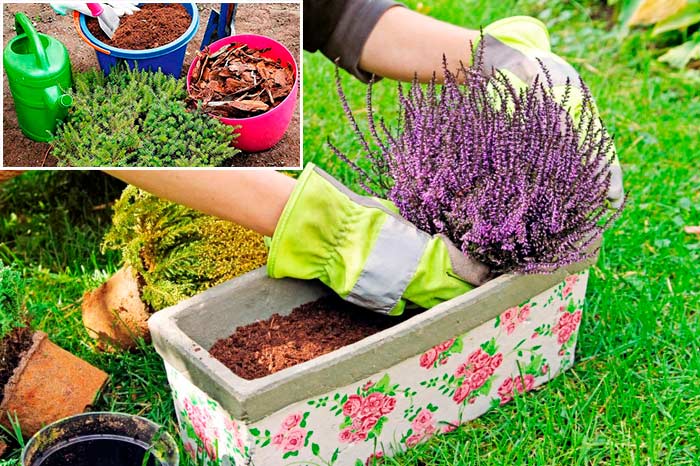

Landing technology
Home heather can be grown from seeds or cuttings. Planting should be carried out only in the warm season - in spring or early summer, in order to provide temperature conditions in the range of 18-22 ° C, necessary for rooting and adaptation of seedlings. The choice of method depends on the skill of the crop and personal preference.
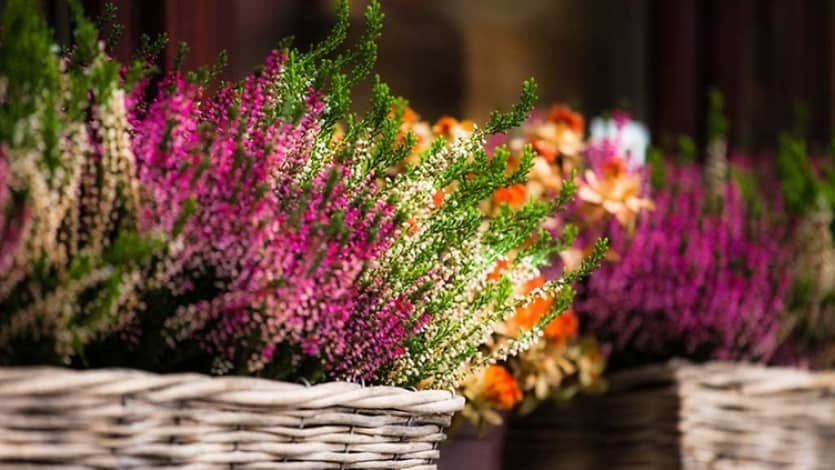

Growing from seeds
Heather planting material is very small, so you need to work with it very carefully. Presowing treatment is not carried out. Landing technology:
- Put a layer of drainage and soil in a common spacious container, pour a little warm water over it and loosen the surface layer.
- Sprinkle the seeds on the surface of the substrate, sprinkle on top with a layer of river sand up to 3 cm thick.Slightly water the planting, cover the container with glass or transparent film, put in a warm and bright place.
- The first shoots appear within 21-28 days, during this time you need to regularly ventilate the soil, and also spray it with water to prevent it from drying out.
- After the appearance of the first leaves, the seedlings can be taken out for several hours on the balcony or loggia for hardening, gradually increasing the procedure time.
Transplantation into a permanent individual pot is carried out after 8-10 months, when the young plants are fully strengthened, a strong root system will form.
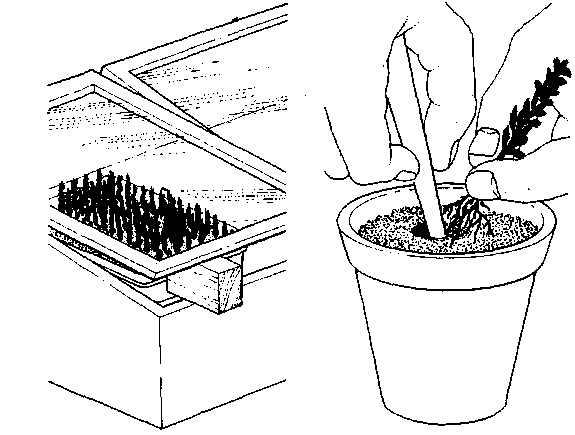

Cuttings
Already rooted heather cuttings can be found in the store to prepare them yourself. To do this, you need to cut off the shoot up to 10 cm long, and then place it in a pot with a peat-sandy substrate. Rooting takes a long time, the process can take up to a month.
During this period, the soil should be watered regularly, and the temperature should be maintained in the range of 15-22 ° C. It is recommended to transplant to a permanent place after 3-4 months, when the stalk is completely stronger.
It is believed that heather grown in this way is distinguished by its resistance and strong immunity to diseases.
Heather ancient omens and superstitions
Ancient signs say that if a guy gave a girl a bouquet of heather, it meant that his feelings had cooled. A bunch of lilac buds served as a hint of parting. Popular superstitions differ in relation to other heather colors. The red flower is a symbol of passion, it was presented as an admiration for female beauty. The white variety means protection from harm and is a sign of the fulfillment of a long-awaited desire.
The plant contributes to the addition of capital. You need to carry a twig in your wallet to improve your financial condition and raise your career ladder. In addition, it will help to avoid rash spending.
Important! In order for the bush to help speed up cash flows, you need to collect and dry it yourself.
In the old days, the plant was used for rituals of cleansing the house and expelling negative energy.The twigs set fire to and fumigated the premises, cleansing the house from the evil eye and damage.
Heather of legend and belief
In Scotland, there is an ancient legend about the appearance of a heather bush in this northern country. The Lord decided to decorate the cold desert steppes of Scotland a little. He turned to an oak, but the oak refused to settle there. The Lord went to honeysuckle, but it did not grow in cold conditions either. Rose refused, citing the fact that her delicate petals would not withstand the north winds. And only the heather did not refuse the Lord and inhabited the northern lands of Scotland with a brave flower. For this, the Lord gave the plant a bark, which is strong like that of an oak, and a delicate scent of flowers like honeysuckle.
Therefore, the flower is still a symbol of perseverance in achieving the intended goal. And also sanity, which does not allow you to commit a rash act and stop in time. Beliefs say that a dried twig hidden in clothes will help you succeed and keep you from stupid things.
Another Scotland legend tells of white heather. His symbol was a Scottish princess who was waiting for her husband from the war. In memory of her beloved, she kept a snow-white silk scarf. The princess's loyalty and devotion were rewarded. The warrior returned unharmed. Signs say that now white buds bring good luck and protect women from violence. The constant wearing of such a flower prolongs life, beauty and youth.
What is needed for landing
To grow heather at home, it is important to correctly approach the choice of planting material. The seed propagation method is rather complicated, therefore, the shrub is usually grown from a cuttings.
Its shoots must be flexible and leafy, ending in a bud of growth. The root system of the purchased cutting is closed, which avoids mechanical damage.
A pot for planting heather at home is chosen based on the characteristics of the plant. The depth of the container must be 7-9 cm more than the roots.
It is advisable to choose only large diameter pots or boxes to ensure growth and development of the shoots.
Frequently asked questions and answers to them
Gardeners who are just starting to grow heather have a tough time dealing with it. It is necessary to know how and what to do at each stage of its growth, as well as other features of the culture.
When does the plant bloom?
The flowering time of heather is the end of August. Its great advantage is that even after the flowering period, the inflorescences do not fall off, but remain on the bush, so that the latter does not lose its decorative qualities for a very long time.
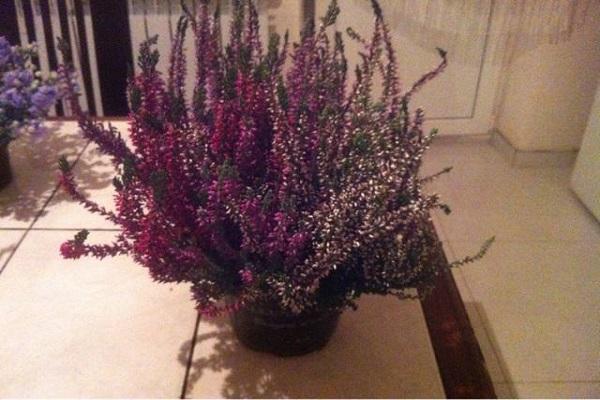

What to do after flowering?
At home, heather is often grown as an annual plant. In order for the bush to survive the winter safely, and the next year to please you with flowering again, appropriate feeding after flowering, as well as cutting, is necessary. It is also important to keep temperatures low during the winter months.
What is the lifespan of a plant?
In the garden, heather can bloom for a long time - up to 5 years, while in nature its life is sometimes counted for decades. But at home, this period is much shorter - 1 or even 2 years, if all the necessary conditions are created.
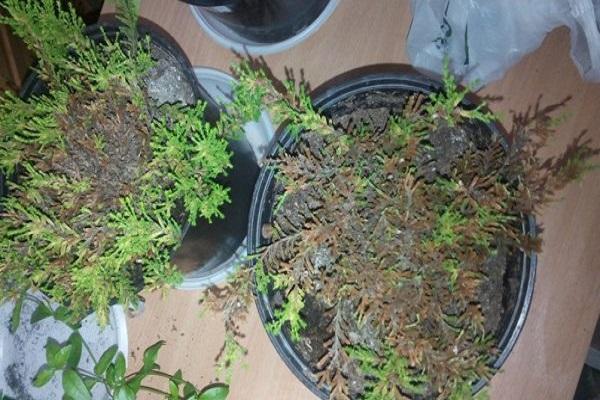

Why does heather dry?
Heather dries up from lack of moisture. In dry seasons, you need to provide abundant watering, do not forget to spray the plant, humidify the air, if possible. Also, the reason may lie in the soil, which has become slightly acidic. This requires appropriate feeding, for example, you can add acid with water twice a year.
Despite the difficulties in planting and growing, heather remains one of the most interesting and useful plants. In addition to beautiful flowers that can be admired for a very long time, it is also used in medicine, cosmetology, therefore it is highly valued by gardeners.
Reproduction methods
Heather can be propagated by seedlings and seeds, and both methods give good results. If you keep the temperature at home, you can breed heather at any time of the year.
Saplings
Propagation with seedlings is a fairly quick and easy way. Cuttings for this purpose should be:
- flexible;
- with vegetative buds at the ends;
- annuals;
- without flowers;
- from the tops of the bushes.
They are recommended to be planted in special pots, in a peat-sand mixture. Choose autumn for breeding.
Seeds
Seeds are the safest way to breed heather. Germination rate is 90%, moreover, the time of year affects less planting of seeds. However, seeds require more time and labor than seedlings. Sowing takes place as follows:
- Pour the prepared soil with warm water.
- Spread the seeds on the ground, lightly press them down and sprinkle with soil on top.
- To prevent the earth from drying out, cover the pot with plastic wrap.
Seeds sprout in about a month. You can also stand the seeds off the ground, in cups or saucers. To do this, they are laid out in a dish in a thin layer, poured over with water and also hermetically closed. After the first shoots appear, they are planted in pots.
Prerequisites for a flower
In an apartment, heather lives less than in the wild or in a garden - up to two years. In order for the plant to delight with flowers all this time, it is necessary to grow it correctly and then take care of it.
Location and illumination
When choosing a room in which you plan to grow heather, you need to consider the following:
- it must be well ventilated;
- the plant is harmed by heat, so you need to prevent overheating (do not place next to heaters and batteries);
- a lot of diffused sunlight.
The ideal option is an insulated loggia, where the desired temperature will be kept in winter. But avoid the south side and direct sunlight.
Temperature regime
High temperatures are fatal for heather. Therefore, in winter, + 12-15 degrees is enough for him, in summer - up to +25. When growing seedlings, try to keep the temperature around + 18-20. Contraindicated to the plant and stuffiness. On the other hand, temporary taking out to the street in spring and autumn on warm (but not hot!) Days will have a good effect.
Indoor humidity
An abundance of moisture is important for heather; in rooms with dry air, it will grow poorly. To avoid this, gardeners are advised to spray the bushes.
Optimal soil composition and pot volume
A shallow and wide pot is best for heather, but when planting the plant, you need to focus on the roots. The depth of the container should be greater than their length, and as the heather grows, it should be transplanted into a larger pot. Often heather is planted in long boxes, then you can assemble a composition of several varieties.
As for the land, the best option is an acidic soil with a base of peat and humus, in which there will be a sufficient amount of organic matter. Good drainage is also important.
Bread as a symbol of death
Of all the rooms in the house, the kitchen, perhaps, has overgrown with the largest number of rules, traditions, and of course, superstitions. In France, a loaf has two sides - "good" (convex) and "bad" (flat). Frenchwoman annie ROGER says that putting bread flat side up can lead to misfortune and even death of someone close: “My grandmother used to say:“ Put bread with the good side up or evil will come into the house ”. I don’t know if this is really so, but just in case I always put it right. ”


Description
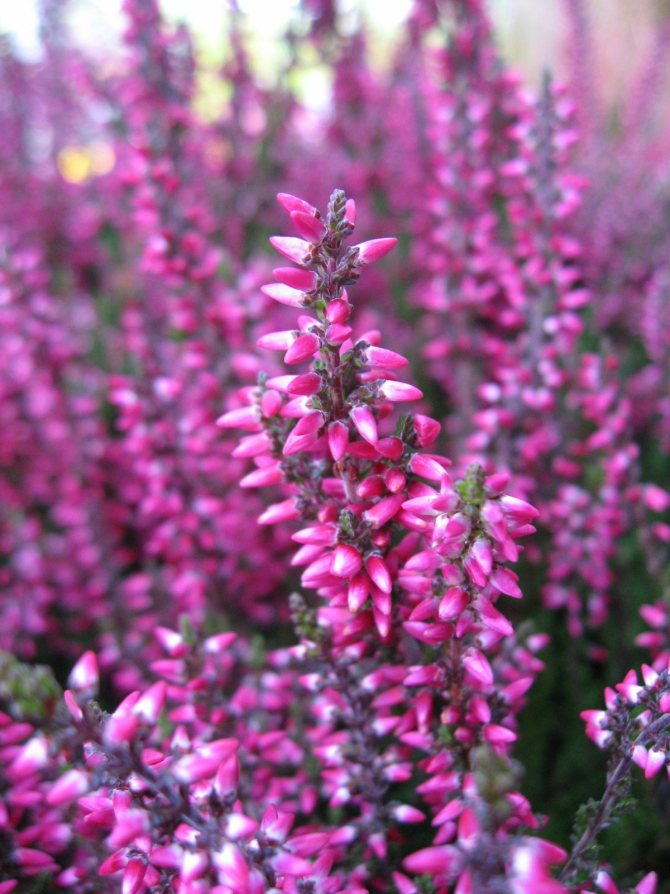

Photo:
A small, very branched bush with small evergreen leaves. Flowers are small, bell-shaped, lilac, lilac-pink. Varieties with large flowers of various shades have been bred. In nature, heather blooms from August to November. The fruit is a capsule. The plant is medicinal, has a beneficial effect on the nervous system, calms the nerves, normalizes sleep.
Mirrors are like windows to another world
In some countries, it is believed that a mirror is a kind of passage to heaven, hell or another other world. For example, the Spanish user 100to14 says: "We are taught from childhood that we cannot make wishes in front of a mirror, because it has a connection with the so-called other side of being."In Eastern cultures, such as Singapore and Japan, older people believe that it is not worth putting a mirror in the bedroom, because it can confuse the soul when it returns to the body after sleep. Similar ideas are reflected in literature, for example, in the book "Alice Through the Looking Glass" by Lewis Carroll, where Alice enters a fairy-tale world, passing through a mirror. In fact, before the invention of cameras and camcorders, only a mirror gave people an idea of how they looked from the outside. Therefore, it is not surprising that many beliefs attribute mystical power to mirrors. Sarah from the UK says there is a saying in her country: "Fear the day you break your mirror." This superstition is rooted in the days of ancient Rome, when people believed that the fragments of a broken mirror could captivate the soul and bring seven years of misery.



